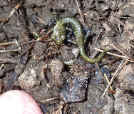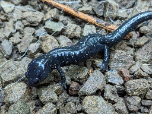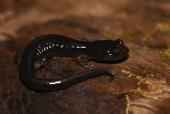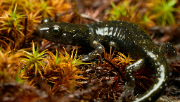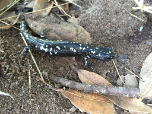Speckled Black Salamander (Aneides flavipunctatus)
Description: Adults measure 2 to 3 3/4 inches long from snout to vent, and up to 5.5 inches total length. A medium-sized salamander with two nasolabial grooves and 14 - 16 well-defined costal grooves. Dorsal coloring varies depending on the locality - it can be solid black, black with fine white specks, black with large white spots, black with pale yellow spots, black frosted with green or gray, or black with many small white spots. The venter is greyish black. Males have a broader head than females. Young are black with a brassy or greenish coloration and yellow at the base of the limbs.
Habitat: Occurs in mixed deciduous woodland, lowland coniferous forests, coastal grasslands. Found under rocks near streams, in talus, under damp logs, and other objects.
Range: Occurs near the coast north of the San Francisco Bay Area from Sonoma county north along the coast and coast ranges to Humboldt and Trinity counties and east into Lake, Napa, Yolo and Colusa, counties and possibly north into Glen and Tehama counties.
Found in these States:
CA
Diet: Diet consists of a variety of small invertebrates, including millipedes, ants and termites. As salamanders grow larger, they eat fewer, but larger prey items.
Reproduction: Reproduction is terrestrial. Courtship and breeding behavior is not well known. Breeding males have a well-developed mental gland. Females probably lay from 8 to 25 eggs in moist cavities belowthe ground in July and August. Eggs are attached by peduncles. Females stay with the eggs until they hatch. Young develop completely in the egg and hatch fully formed.
Status: Listed as Least Concern in view of its wide distribution and presumed large population.
»» Kingdom: Animalia - Animals
»» Phylum: Chordata - Chordates
»» Subphylum: Vertebrata - Vertebrates
»» Class: Amphibia - (Amphibians)
»» Order: Caudata - Salamanders
»» Family: Plethodontidae - Lungless Salamanders
»» Genus: Aneides
»» Species: Aneides flavipunctatus - Speckled Black Salamander
This article uses material from the Wikipedia article "Speckled Black Salamander", which is released under the Creative Commons Attribution-Share-Alike License 3.0. Content may have been omitted from the original, but no content has been changed or extended.
|



